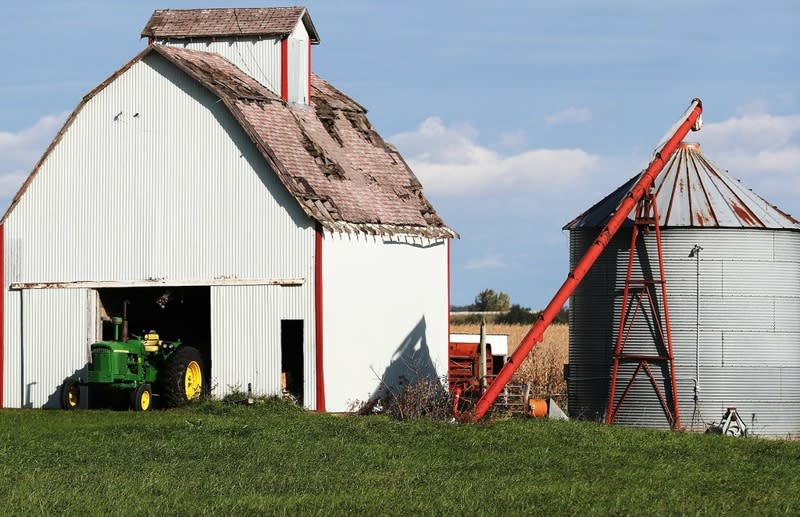Rural identity emerging as key factor in politics

- Oops!Something went wrong.Please try again later.
(Photo by Getty Images.)
Most observers link identity politics with Democrats, as underrepresented groups have used their common fate as a vehicle for political action since the movement politics of the 1960s & 70s.
The political science literature has highlighted another key identity emerging in politics in recent years: rural identity. We have always had a rural/urban divide; think of Hamilton’s view of the virtue of burgeoning cities versus Jefferson’s ideal of an agrarian republic. But recent work by Katherine Cramer as well as Nicholas Jacobs and Daniel Shea highlights how a growing common identity, even across varied and far-flung rural America, adds to our political cultural divide.
Jacobs and Shea pinpoint the 1980s as when this identity began to crystallize. In different regions, cost pressures on family farms and ranches, suburban sprawl, or water inaccessibility squeezed rural communities economically, which coincided with terrible depictions of country life in popular culture. Just as national news outlets emerged through cable and the internet, regional papers closed, and divisive national narratives enveloped local political context. Separate localized identities merged into a national common rural identity.
Simultaneously, globalization shuttered small manufacturers central to communities’ economies, so younger generations moved to bigger cities, and social issues and addiction grew. For Cramer, a key component of this rural identity is a resentment from the perception of being overlooked by government. It has furthered party polarization as rural Americans increasingly vote Republican and see the world opposite from group identities associated with Democrats and vice versa.
One could argue that rural America is more Republican because of demographics and cultural conservatism. Rural America is whiter, older, and more religious, but in multiple surveys, Jacobs and Shea control for these factors and find that rural identity independently adds to Republican support. Moreover, on issues of race, LGBTQ+, and immigration, rural Republican whites are typically only slightly more conservative than their suburban and urban Republican counterparts and their news consumption patterns are not distinctive either.
Donald Trump did not create this identity; Cramer’s study tied rural resentment in Wisconsin to the rise of Gov. Scott Walker years earlier. True, Trump’s rhetoric supercharged the resentment angle of this identity – 2016 and 2020 were all about identities colliding across parties – but politically energized rural identity already existed – Sarah Palin’s meteoric rise evidenced that.
What does this mean? Overlapping group and party identity means people use identity-based filters to view politics and see their group as winning or losing relative to other groups. As Marc Hetherington and Jonathan Weiler argue, groups’ contending worldviews mean others aren’t just wrong on policies; the other side causes problems that policies need to solve. Democrats threaten the American way of life for Republicans and, to Democrats, Republicans keep America from changing to reach its promise.
With identities colliding in 2024, things seem grim. The way forward is to separate identities from resentment by reframing the actual problems driving it. Like now in rural areas, in the Detroit area of my youth, economic dislocation, population decline, and drug addiction were vivid crises, but were typically categorized as racial issues. Ironically this meant the issues became identity-based rather than universal and helped to drive the very wedge between rural and urban Democrats that has left few Democrats representing rural America anymore.
Both parties do not have to try to empathize across lines if they do not try to even compete for regions of America. From leaders, people with common identities see their fortunes pitted against others, which furthers polarization.
What this rural identity research indicates is that the actual underlying issues that drain the quality of life from communities are affecting everyone – in big cities and small towns – and we have avoided the heavy policy lift on inequality, immigration, and addiction, all while politicians avoiding these issues trigger other citizens based on less salient, and sometimes even bogus, culture war issues that inflame identities and polarization.
Despite the heat of this election year, there have been wins. The bipartisan infrastructure bill has substantial benefits for both rural and urban America. The bipartisan CHIPS and Science Act and common views on Chinese tariffs by both presidential contenders recognizes that offshoring broke communities and hurt industrial America in rural and urban areas. Even if free-traders might disagree, globalization outstripped the public’s patience.
This literature leaves the reader to question: why are we letting people divide us on beer brands and symbolic distractions when genuinely common economic and social issues remain insufficiently addressed?
Indiana Capital Chronicle is part of States Newsroom, a nonprofit news network supported by grants and a coalition of donors as a 501c(3) public charity. Indiana Capital Chronicle maintains editorial independence. Contact Editor Niki Kelly for questions: info@indianacapitalchronicle.com. Follow Indiana Capital Chronicle on Facebook and X.
GET THE MORNING HEADLINES DELIVERED TO YOUR INBOX SUPPORT NEWS YOU TRUST.
The post Rural identity emerging as key factor in politics appeared first on Ohio Capital Journal.

